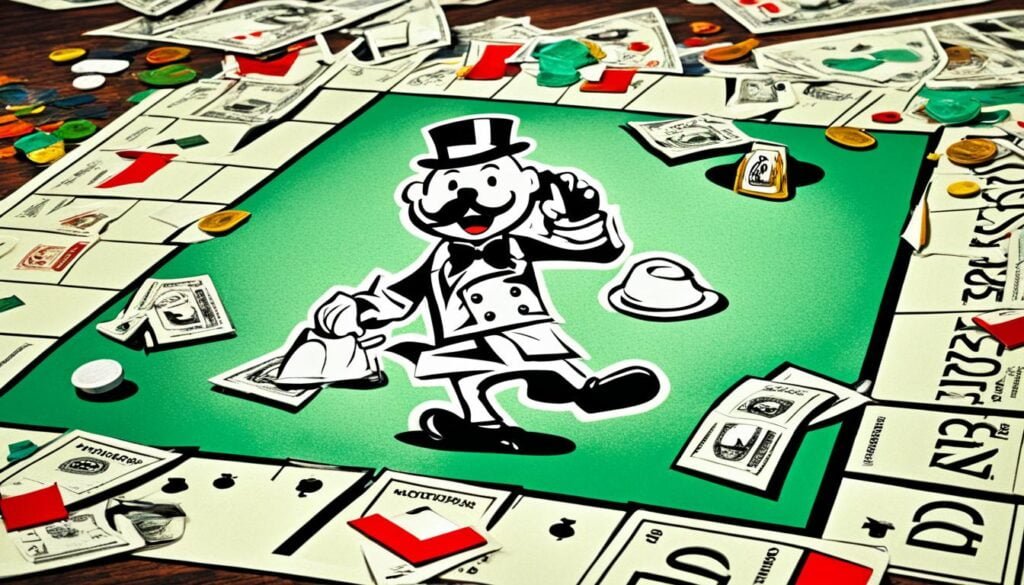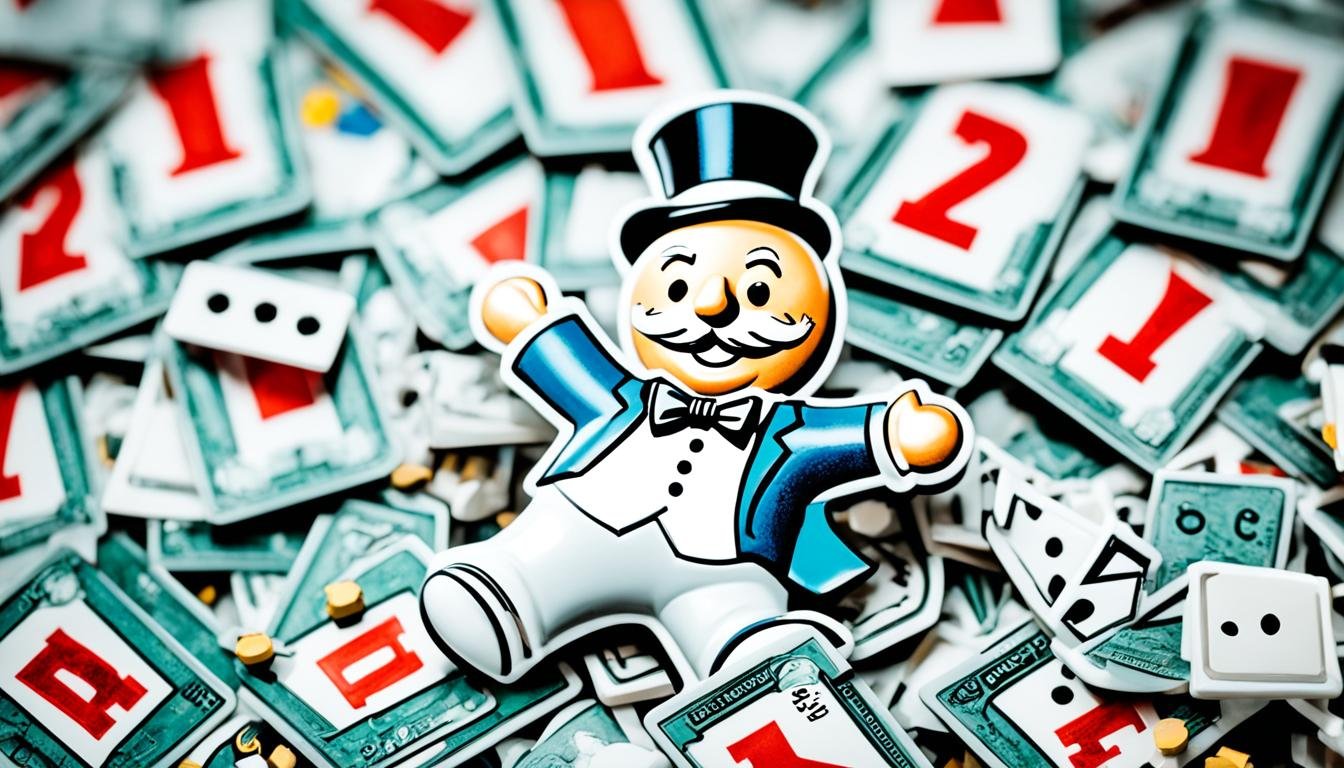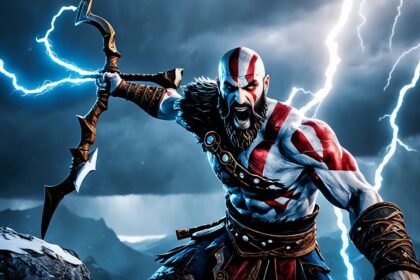Monopoly is a board game loved by families all over the world. It’s packed with fun and strategy. Every player picks a playful token. One of the most famous tokens is Mr. Monopoly. Otherwise known as Rich Uncle Pennybags.
His familiar face first showed up in 1936 on Chance and Community Chest cards in the U.S. editions. Then, in 1946, a game called Rich Uncle was released. It had his image on the box, money, and rules. That’s when he got his official name, Rich Uncle Pennybags.
Between 1985 and 2008, Mr. Monopoly was in the Monopoly title logo. That’s not all. In 1999, they officially called him Mr. Monopoly instead of Rich Uncle Pennybags.
Mr. Monopoly is more than just a game piece. He’s been part of big moments. Like the time he showed up at a U.S. Senate hearing in 2017. A guy dressed as Mr. Monopoly showed up in the background. He was trying to make a point about money and power.
Artists also use Mr. Monopoly to talk about big issues. Alec Monopoly is one. His art uses Mr. Monopoly to talk about money, shopping, and big companies. It’s a way to start a conversation about how society works.
Key Takeaways:
- Mr. Monopoly, also known as Rich Uncle Pennybags, is one of the most recognizable characters in the Monopoly game.
- He first appeared on Chance and Community Chest cards in the U.S. editions of Monopoly in 1936.
- Mr. Monopoly was officially named in 1946 with the game Rich Uncle, where his likeness appeared on the box lid, instructions, and currency.
- Between 1985 and 2008, he appeared in the second “O” in the Monopoly logo.
- In 1999, the character was renamed from Rich Uncle Pennybags to Mr. Monopoly.
- Mr. Monopoly has been depicted in various TV shows and has become an iconic symbol in pop culture.
- Graffiti artist Alec Monopoly utilizes the Monopoly Man character in his artwork to satirize capitalism and societal economic issues.
The Origins of Monopoly
The game Monopoly has a long history, starting in the early 20th century. Elizabeth Magie patented a board game similar to Monopoly called The Landlord’s Game in 1904.
Lizzy Magie made The Landlord’s Game to highlight economic issues like the rich getting richer through land grabs. She wanted to push the idea of taxing property owners more.
However, the game we know as Monopoly got famous in the 1930s thanks to Charles Darrow. He made a homemade version with Atlantic City street names, including a typo for Marven Gardens.
The debates over Monopoly’s real origin add mystery to its story. It shows why Monopoly still captures our interest in wealth, power, and winning.
The Evolution of Monopoly
Monopoly has grown since its start, with many people contributing to its development by the 1930s.
In 1991, Hasbro bought Parker Brothers, solidifying Monopoly’s place in many homes. Since then, newer versions beyond Atlantic City or London have been made for global appeal.
Another big change came with the 3-D Mr. Monopoly symbol introduced by Hasbro. Now, this logo is widely recognized by game fans.
Gameplay also evolved. Hasbro changed the US Monopoly’s look to match the UK version in 2008. They also added a Speed Die, which sped up gameplay.
| Monopoly Facts | |
|---|---|
| Number of People who have Played Monopoly Worldwide: | Over a billion |
| Number of Countries Monopoly is Available in: | 114 |
| Number of Languages Monopoly is Translated into: | 47 |
Monopoly is loved around the world and has sold millions of copies. The book “The Monopolists: Obsession, Fury, and the Scandal Behind the World’s Favorite Board Game” by Mary Pilon reveals its true story.
The Evolution of Mr. Monopoly
Monopoly has changed a lot over the years, and it’s not just the board. The game’s tokens have also seen a lot of updates. Early versions had famous ones like the top hat and thimble. But, newer editions have brought in tokens like the sack of money and even a cat.
Some original pieces, such as the boot and battleship, let players feel a sense of history. These tokens showed parts of everyday life. Choices like the cannon and racecar spiced up the game with adventure.
Monopoly keeps up with the times by adding new tokens, too. The sack of money and cat reflect wealth and friendship. Then there’s the t-rex and rubber ducky, which add fun. Each new piece adds its own joy to the game.
New themes and interests are seen in more recent additions to Monopoly’s tokens, like penguin and lantern. They help the game stay fresh and inviting for players, both old and new.
As the game grows, its tokens change. This shows how Monopoly stays interesting and relevant over time. So, whether you choose the wheelbarrow or the horse and rider, you’re adding special fun to the game.
Evolution of Mr. Monopoly’s Tokens
| Year | Tokens |
|---|---|
| 1936 | Top Hat, Thimble, Iron, Boot, Battleship, Cannon, Racecar |
| 1946 | Purse, Rocking Horse |
| 1950s | Lantern, Scottie Dog, Wheelbarrow |
| 1990s | Horse and Rider, Sack of Money, Cat |
| 2000s | T-Rex, Rubber Ducky, Penguin |
Rich Uncle Pennybags vs. Mr. Monopoly
In the Monopoly game, one character truly stands out: Rich Uncle Pennybags. He’s known for his top hat, white mustache, and cane with a silver Monopoly Dollar sign.
In 1999, he got a new name, Mr. Monopoly, which made him more modern. Now he’s a big part of pop culture, even appearing in shows like The Simpsons.
Mr. Monopoly is all about wealth, excess, and chasing material success. As Monopoly’s mascot, he’s seen as a symbol of wanting more and capitalism. Yet, people love this iconic figure from the game.
Over the years, different actors have given Mr. Monopoly his voice. Thanks to Tony Waldman, Tony Pope, and Wendell Johnson, he’s more than just an image.
“Mr. Monopoly has become a pop culture icon, representing wealth and capitalism. His image and persona have made a lasting impact on our society.”
Mr. Monopoly is a big deal, even in fictional wealth. He was once the sixth richest fictional person on the Forbes list. He truly represents the elite.
He’s not just in the game. Mr. Monopoly appears in public events and different media, showing he’s an icon of our culture. He’s even been part of protests.
Inspiring Art and Social Commentary
Mr. Monopoly is more than a game character. He’s inspired art and commentary on our economic system. Artists, like Alec Monopoly, use him to talk about consumerism and greed.
Alec Monopoly’s art is well-known. His paintings and murals featuring the Monopoly Man spark important conversations. They discuss wealth inequality and the issues with capitalism.
Mr. Monopoly has also shown up in comic books. In Clue: Candlestick by Dash Shaw, he makes a special appearance, showing he’s a part of our pop culture.
The Monocle Misconception
Many think Mr. Monopoly wears a monocle. This idea is from the Mandela effect. This effect happens when many people remember things wrong. So, people wrongly think Mr. Monopoly has a monocle because they mix him up with Mr. Peanut. Mr. Peanut is known for his monocle.
The Mandela effect makes many people remember things the same, but wrong. It’s named after a big mix-up about Nelson Mandela. Despite being set free and becoming South Africa’s president, some thought he died in jail.
The mix-up might happen because Mr. Monopoly and Mr. Peanut look alike. They both wear fancy clothes and carry canes. But Mr. Peanut has a monocle, not Mr. Monopoly. This is why people think Mr. Monopoly does too.
If wrong information is repeated enough, people believe it. Even if there’s no proof. This is how the idea that Mr. Monopoly has a monocle got stuck in people’s minds.
It’s key to know fake memories from real facts, especially in things like Mr. Monopoly. Learning why we remember some things wrong helps us see how memory works. And how hearing something over and over can change what we believe.
Alec Monopoly and the Monopoly Man
Alec Monopoly is a famous graffiti artist known for adding the Monopoly Man to his art. He comes from New York City. Alec mixes street art with a message about money, shopping, and big business.
Alec works in many cities, like Miami and Los Angeles. He uses stencils, spray paint, and newspapers in his art. His pieces often show famous figures with the Monopoly Man. People who love art and those who are just passing by find his work interesting.
Celebrities like Philipp Plein and musicians like Miley Cyrus admire Alec’s work and buy his art. Their support shows how important Alec is in the art world.
Alec also does other creative things. In 2010, he showed his art in a New York gallery for the first time. He also joined an art exhibition at the Mondrian Hotel during Art Basel in Miami. This helped more people see and know about his art.
2021 was a big year for Alec outside his art. He worked with Barstool Sports to sell special merchandise. The money went to help small businesses during the COVID-19 crisis. This project was an example of Alec’s desire to help through his art.
A film called “Pay 2 Play: Democracy’s High Stakes” in 2014 is all about Alec’s art. This documentary shows how Alec uses his art to talk about important issues. His art is known all around the world for its strong messages and bright colors.
For more about Alec Monopoly and his art, there are lots of articles and interviews available. They talk about how Alec makes his art and what inspires him. These pieces can give you a closer look at Alec Monopoly, the artist.
Overall, there are 377 pieces of art linked to Alec Monopoly and the Monopoly Man. The prices of his art can vary a lot. In European galleries, his art ranges from €2,000 to €75,000. In the US, his art can go from US$59,963 to US$74,963. His art is popular and its value changes depending on many factors.
The Legacy of the Monopoly Man
The Monopoly Man is recognized by his top hat and mustache. He is an icon in both pop culture and art. Known as Rich Uncle Pennybags or Mr. Monopoly, he symbolizes wealth and capitalism.
In today’s art, the Monopoly Man is a key figure. Artists use him to talk about problems with our economic system. For example, artist Alec Monopoly uses the Monopoly Man in his work to discuss issues like consumerism and income inequality.
The Monopoly Man helps artists share their messages in a clear way. He represents the world’s social and economic challenges. This makes him an important figure in art and commentary.
The Monopoly Man shows up in paintings, murals, and graffiti. This shows his power as a symbol and how he sparks conversation. Artists use him to challenge accepted ideas and make people think deeply about society.
“Art can break barriers and inspire change. The Monopoly Man, through his famous image, pushes discussions on society. In different art forms, he keeps people thinking about what lies beneath appearances.”
The Monopoly Man’s image is still linked to money smarts and wisdom. His mustache is known to everyone, from grandparents to kids. The game Monopoly and the Monopoly Man are key parts of pop culture and family fun.
| Year | Event |
|---|---|
| 2017 | A staff member of Public Citizen dressed as Mr. Monopoly and photobombed the CEO of Equifax during a U.S. Senate hearing, drawing attention to consumer rights in financial companies. |
| 2018 | A person dressed as the Monopoly Man was seated behind Google CEO Sundar Pichai during his testimony before Congress. |
| Various | In licensed media, Mr. Monopoly has been voiced by several voice actors, including Tony Waldman, Tony Pope, Wendell Johnson, Dean Hagopian, Mark Dodson, Larry Moran, Michael Cornacchia, Harry Aspinwall, and Rowell Gormon. |
| Various | In the Clue: Candlestick comic book, Rich Uncle Pennybags makes a cameo under the name “Milburn.” |
The Monopoly Man remains a big figure in pop culture and art. His image will keep sparking talks about society and bringing about change.
The Monopoly Man in Media and Public Events
Over the years, the iconic Monopoly Man has won the hearts of many. He’s not just in board games. You can find him in the media and public protests too. The Monopoly Man is seen challenging big corporate power. He’s a symbol of fighting for fairness and against greed.
A special moment happened when former Equifax CEO Richard Smith testified. Amanda Werner showed up as the Monopoly Man. It became a huge deal with over 42,000 tweets mentioning the ‘Monopoly Man’. This event was a fun yet serious way to talk about wealth and big business issues.
Photos from these events went viral. They were shared by finance experts, stars, and regular people. This shows how using a well-known figure draws attention to important topics. It starts conversations that matter.
The Monopoly Man has become a star, even appearing in TV shows. He wears a fancy top hat and looks very wealthy. His look reminds people of the problems with money and power. People easily connect him to these big issues.
Activists have used the Monopoly Man well. By putting him in the spotlight, they’ve talked about big problems in a fun way. This grabs attention and gets us talking about serious stuff with a lighter heart.
Using the Monopoly Man in these ways proves that the Monopoly game itself holds lasting value. It’s more than just a game. It makes us think about fairness, money, and power in society. The game keeps our conversations going strong.
The Monopoly Man continues to be a big deal in the media and at public events. His look is a reminder of what the game shows us. He stands for fairness and fighting against big business power. The Monopoly Man keeps us thinking about the world in a deep way.
The Monopoly Man and the Mandela Effect
The Mandela Effect is named after Nelson Mandela. It’s when people remember events differently from how they truly happened. This shows we can’t always trust our memories.
The Monopoly Man is an interesting example of the Mandela Effect. Many think he wears a monocle. But, he never has, even since the game was made in 1936. This mistake is so common it’s often used to explain this memory phenomenon.
Rich Uncle Pennybags, or the Monopoly Man, represents wealth and capitalism in the game. Even though he doesn’t have a monocle, people still believe he does. This error in memory shows how our minds can create and share wrong information.
False memories are often linked to things we see in movies or on TV. Since the Monopoly Man is seen as wealthy, and some wealthy people do have monocles, this error makes sense. It’s likely why people remember him with a monocle, even though he doesn’t wear one.
Just like how Darth Vader never said “Luke, I am your father” in Star Wars, the Monopoly Man never wore a monocle. It’s a fascinating example of how our memories can be unreliable.

Learning about the Mandela Effect and false memories teaches us about our minds. It shows how we might not always remember things as they truly are. This is a big reason to question our memories and think critically about what we believe.
Exploring the Mandela Effect and the Monopoly Man’s monocle myth shows our memory’s limits. The Monopoly Man story highlights how our shared culture can lead to false memories. It shows how much our world can influence the way we remember things.
Conclusion
In conclusion, Mr. Monopoly has an amazing history that’s more than a century old. It started in 1904 as a board game piece made by Elizabeth Magie. By 1985, it was officially made part of the Monopoly game by Parker Brothers.
The Monopoly Man, Rich Uncle Pennybags or Mr. Moneybags, stands for wealth and capitalism. He’s known around the world and is featured in many art forms and events. Artists, like Alec Monopoly, have used him to talk about society’s problems and make us think.
Even today, Monopoly is a favorite for family game nights and tournaments have been happening since the 1970s. Hasbro keeps the game fun with new versions like video games and different board styles. Over the years, Monopoly has changed its look and added new rules and features.
To sum up, Mr. Monopoly’s story shows the game’s lasting popularity and its impact on culture. Whether you’re playing with loved ones or competing in a world tournament, Monopoly remains a top choice. It’s a game that brings joy and inspiration to everyone, regardless of age.
FAQ
What is Monopoly?
Monopoly is a classic board game. It’s known as a property trading game. Players use special tokens to move around the board. Their goal is to get rich by buying properties.
Who created Monopoly?
Lizzy Magie invented Monopoly in the early 1900s to criticize the Gilded Age. It was later made popular by Charles Darrow in the 1930s.
What are some of the original Monopoly tokens?
At first, the game had the top hat, thimble, and iron tokens. But these tokens are no longer used.
Who is Mr. Monopoly?
Mr. Monopoly, also called Rich Uncle Pennybags, is the face of Monopoly. He is a symbol of wealth and capitalism.
Does Mr. Monopoly wear a monocle?
No, Mr. Monopoly doesn’t wear a monocle. Some people mistakenly remember him with one. This is due to the Mandela effect.
Who is Alec Monopoly?
Alec Monopoly is a famous graffiti artist. He often features the Monopoly Man in his art. His art critiques capitalism and greed.
What is the legacy of the Monopoly Man?
The Monopoly Man has made a big mark on pop culture and art. He stands for wealth. Often he’s used in art to talk about society’s problems.
Where has the Monopoly Man made appearances?
We’ve seen the Monopoly Man in media and at public events. For example, at protests and behind CEOs in photos during hearings.
What is the Mandela Effect?
The Mandela Effect happens when many remember something that never actually occurred. Thinking the Monopoly Man has a monocle is an example.
Why is Monopoly considered a classic family game?
Monopoly is a beloved game for families. It’s because everyone can play. It also teaches strategy and brings families together during play.








